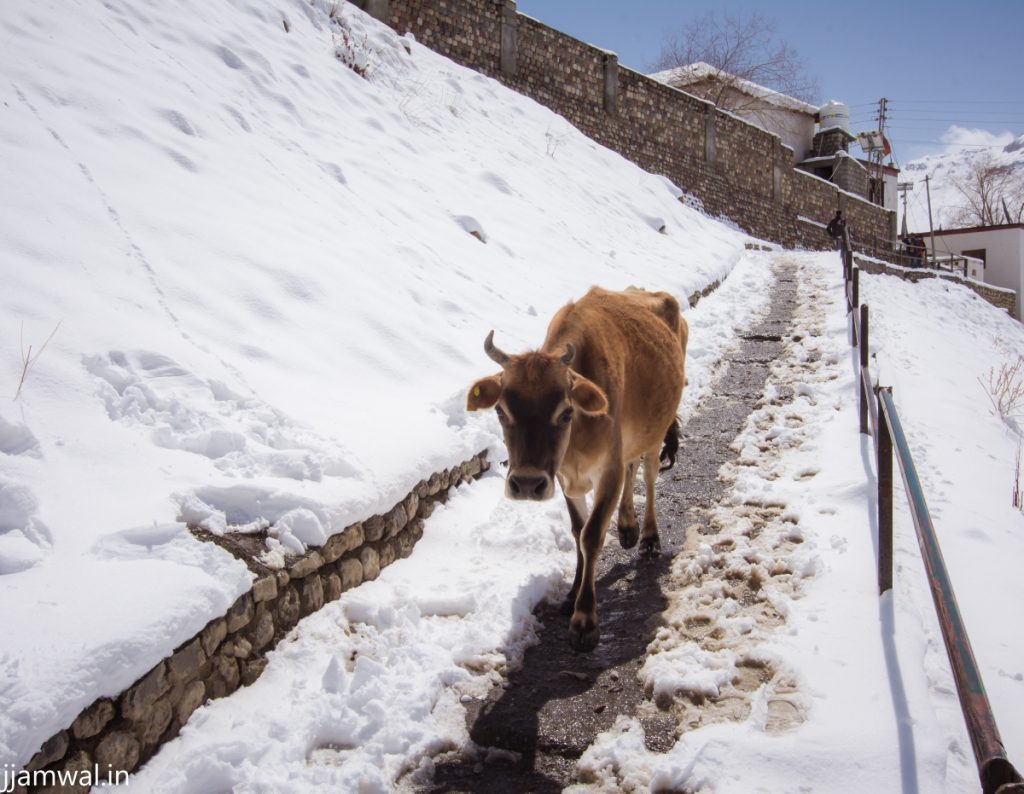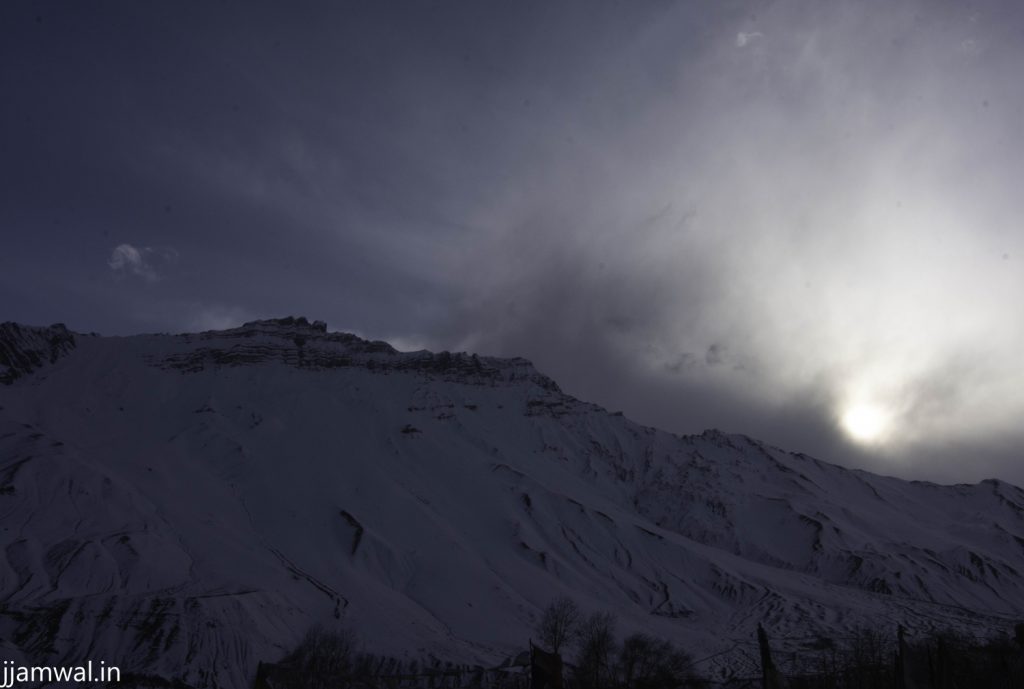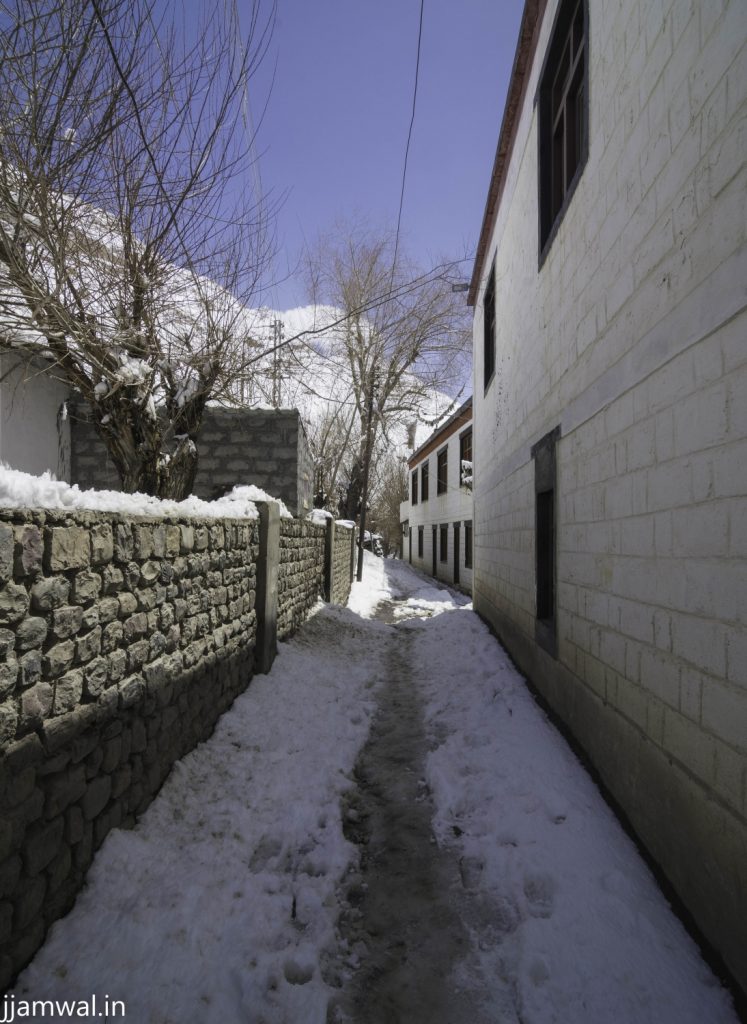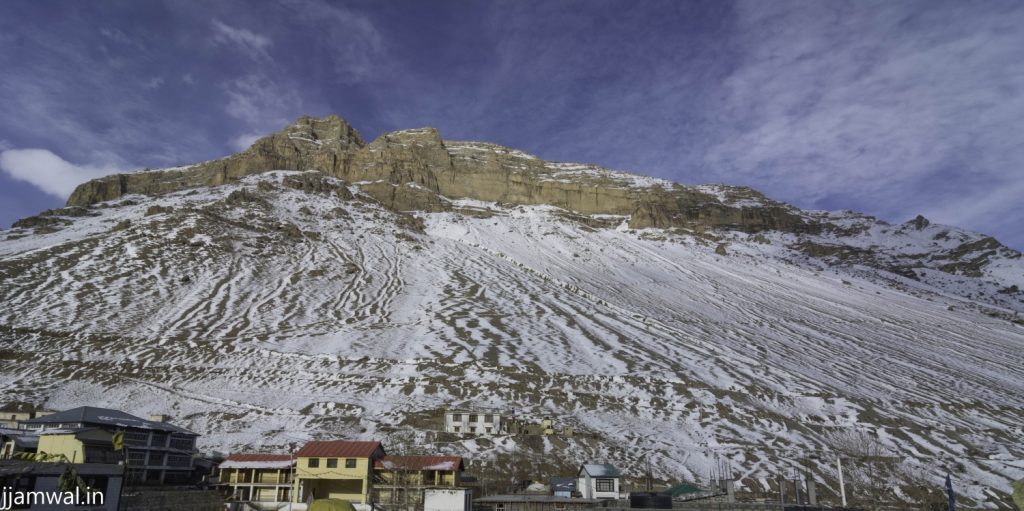The hotel I reached was an old property with worn down furniture and repairs and new construction going on. They didn’t even have the kitchen operational as it was reopened only a few days back. So I went out and found a small dhaba for a meal of kadhi chawal. After coming back, I had a bit of chat with the owner and he said that there were 15-18 migrant labourers staying in his basement waiting for the same bus to Kaza I was supposed to catch the next morning. Interesting.
I woke up next morning around 4:30 am as the bus was supposed to leave at 5:30 am and had to wake up the hotel’s owner to let me out. He was kind enough to accompany me to the bus stand and use his contacts to get me a ticket which would have been an ordeal considering the number of people at the counter. It was a rainy day with a bit of sleet so indoors were more cramped than usual too. I wish I could write a few lines about the view of majestic Kinner Kailash mountains at sunrise, but unfortunately it was all covered by thick clouds. I rarely ever wake up at dawn or sooner, so the labour effort was wasted a bit. I managed to get a seat right next to the front window. It had a bit more room but also let in quite a bit of cold air. By the time bus climbed down the mountain of Reckong Peo, there were people standing in the bus. Most of them were wearing masks, but it was evident that corona was not a big concern for them at that point.
My last visit was during the late monsoon season and there was a lot more greenery and quite a few waterfalls every now and then. It was a bit drier and there were no waterfalls even with 2-3 days of continuous rain. There was not much snow at the peaks either. First stop was at a place called Spillow for breakfast and the next one was at Nako. I did not like Nako much the first time and it was pretty bad this time too. We had stopped half a kilometer outside the village but lots of crazy unplanned construction was visible from even there. The green pond there which some people called a lake would’ve been in an even worse condition. The road started to get a lot worse from this point onwards too. There was a lot of road work going on everywhere but this section seems to have unusually unstable terrain. I had seen a large landlside last time and that section looked a bit shady this time too.

There was one more stop for lunch and the bus reached Kaza around 4 pm (I think). I was recommended to a hotel by someone I work with and I just checked in, washed up a bit and went out to get something to eat. There was a light snowfall going on and the town was full of surprisingly large numbers of tourists. Even then, there was not much to eat apart from the usual momos (dumplings), chowmein and thupka noodles kind of stuff which passes for authentic Chinese and/or Tibetan food in India. There were two restaurants which had more extensive menus, corporate cool kind of posters and a pretentious clientele which likes to think that they speak english better than their own language. Even those places had nothing apart from the same “chinese” and sandwiches. After a bit of wandering around, I had some mutton momos in a small and dimly lit eatery run by a local woman. The soup was surprisingly good and they also offered to fill up my bottle with hot water. Drinking normal water in that weather was not very comfortable, so that was nice.
My plan was to visit Mudd village in Pinn and stay there for a few days. I had liked Pinn during my last visit and was interested in hiking a bit in the area. It is also a bit off the main trail and not too many tourists visit the place. The local buses to villages were not running due to corona restrictions, so I asked local taxi stand if they were operating. There was just one bored looking man sitting at the counter who said that it depended upon the weather as many roads were closed due to snowfall. I was told to check later in evening or next morning. After that, I walked around the town a little more looking for new stuff. It was not really worth the effort in near continuous sleet. The small river flowing through the middle was covered in trash, lots of ugly concrete buildings were coming up and punjabi, haryanavi and delhi type tourists were trying to drive their cars and loud bullet motorcycles in every narrow street they could see.
I woke up next morning after hearing some loud sounds. It was locals shoveling off snow from their rooftops. It had snowed so much that all of the town was covered in 2-3 feet of snow. The nearby mountains which were brown the previous day were completely white. The houses in this region almost always have flat roofs which are used to store firewood and to dry grass, grains and other such stuff. This means that the people have to shovel off snow from their rooftops after every snowfall. They are still using flat roofs in Kaza even when there are no such activities happening. So walking around in tight lanes of the town was a bit of an adventure as it was not easy to determine which house would dump a shovel full of snow on you.
I called taxi stand and as expected they had no car available due to snow blocking all roads. So I had to stay one more day in Kaza. The owner of homestay in Mudd with whom I had talked with before reaching Kaza was also there. He too didn’t seem very optimistic. The hotel owner refused to take any payment from me because of the reference he had gotten, I think and I didn’t feel right taking advantage of his generosity. So I checked out and found a small guesthouse run by a Nepali. He had a small eatery downstairs which had only meat dishes. He had prepared a Nepali dish out of goat hooves in a curry. It was all gelatinous and just OK for one time tasting. Later in the day, I found a man from Palampur selling gyuma, which is a dish made from goat or sheep intestines. They are washed, cut in to cylinders, filled with a filling made of dough, spices and blood and fried well. I later came to know that it is done with yak too. These goat guymas were fairly big, I can only wonder how big the one from yak would be. Previous day I was cribbing about not having enough variety and had two strange dishes made of stuff which is usually thrown away on the same day.

Since there was nothing better to do, I walked around the town a bit more and took some pictures. The trash in river was covered by snow, so it looked a lot better. I made a few calls to see if there were any accommodations open anywhere else and found one property in Chicham village which was still open. It is right next to the more famous Kibber village, but remained less overrun with tourists because of no road. Until 2017 only the road started from Kunzum side and ended at a deep gorge which had to be crossed by foot or by a rope trolley. I had done a bit of joyride in that trolley during my second visit to Spiti and seen a bridge under construction right next to it. The bridge was inaugurated just a few days before I reached there again in 2017 and I had just passed over without staying in Chicham. The trolley was lying right next to the bridge looking sad. Now that bridge has become a tourist attraction as the highest suspension bridge. Unfortunately, simpletons who think of bridges and tunnels as tourist spots are also some of the most annoying people on the planet. More on that later.
As it happened, the owner of guest house in Chicham had a job in Kaza and said that he had rooms, he was coming to the town the next day and could give me a lift. That worked for me just fine and I was in Chicham by next afternoon. The property was much bigger than I expected and had nearly all modern amenities. Only issue was that there was no running water because streams were dry till snow started melting. Not that there was much of it owing to low snowfall. They did however provide one bucket of warm water in the morning and I had to use the dry toilet which was fine by me. Even Kaza had this problem with water even with it’s location right next to the river. The first hotel I stayed in had multiple water tankers coming in daily. Indian tourists don’t really believe in conserving water. electricity and cleanliness anywhere they go and it makes it even worse for the locals and ecology of the destinations. Hotel’s owner said that he was spending INR 1000 (or something close) on each tank full of water.
This post has gone on to be much longer than I originally planned. Hopefully, I’ll be able to finish this travelogue in the next post.



Leave a Reply